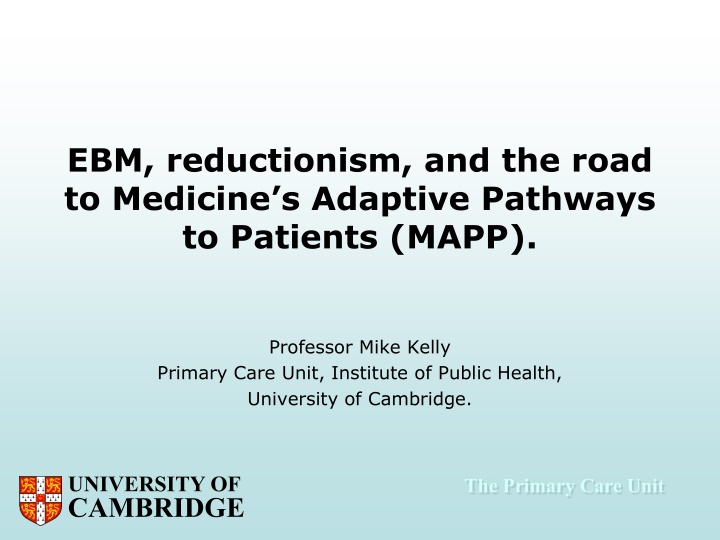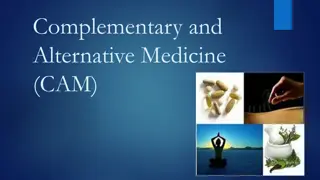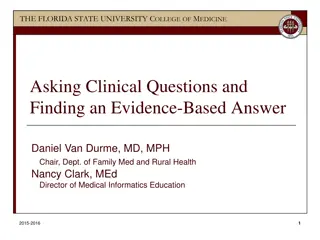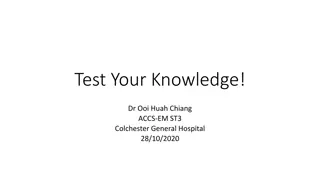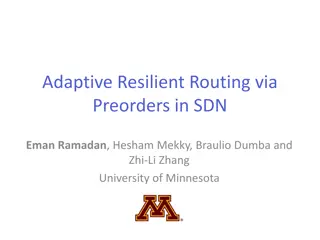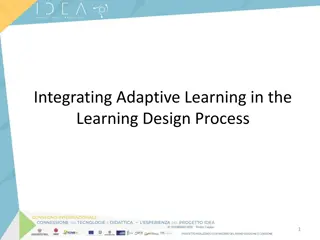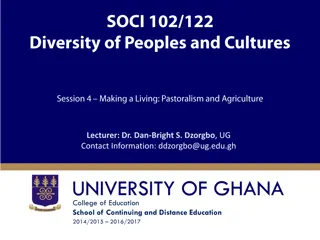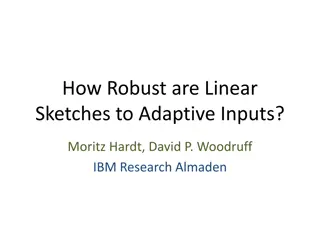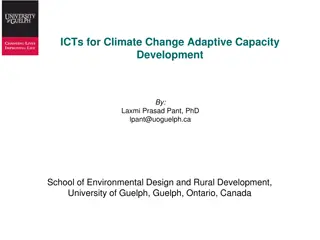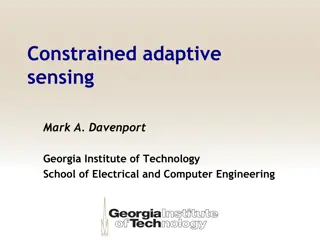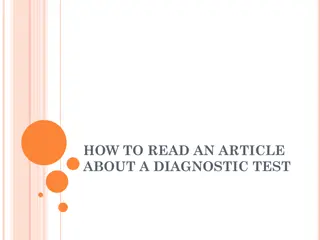Adaptive Pathways to Patients: Exploring EBM and Reductionism in Medicine
This presentation delves into the foundations of Evidence-Based Medicine (EBM) and reductionism, tracing their evolution and impact on healthcare practices. It questions the effectiveness, cost, and safety of medical interventions, highlighting the importance of unbiased evidence in clinical decision-making. Key elements and comparisons of medical interventions are scrutinized through the legacy of Archie Cochrane.
Download Presentation

Please find below an Image/Link to download the presentation.
The content on the website is provided AS IS for your information and personal use only. It may not be sold, licensed, or shared on other websites without obtaining consent from the author.If you encounter any issues during the download, it is possible that the publisher has removed the file from their server.
You are allowed to download the files provided on this website for personal or commercial use, subject to the condition that they are used lawfully. All files are the property of their respective owners.
The content on the website is provided AS IS for your information and personal use only. It may not be sold, licensed, or shared on other websites without obtaining consent from the author.
E N D
Presentation Transcript
EBM, reductionism, and the road to Medicine s Adaptive Pathways to Patients (MAPP). Professor Mike Kelly Primary Care Unit, Institute of Public Health, University of Cambridge. UNIVERSITY OF CAMBRIDGE The Primary Care Unit
The original precepepts of EBM. UNIVERSITY OF CAMBRIDGE The Primary Care Unit
The legacy of Archie Cochrane Effectiveness and Efficiency (1972) UNIVERSITY OF CAMBRIDGE The Primary Care Unit
Do we know whether intervention x for problem y is effective? How do we know it is effective? How do we know whether it is more or less effective than intervention z? On what basis do we make that judgement of effectiveness? Do we know what it costs? And is it cost effective? If it is not cost effective, why is it still being used? What are the dangers posed to the public of interventions and actions about which we are scientifically uncertain? Are the interventions dangerous? Why are we using potentially dangerous or worthless interventions? UNIVERSITY OF CAMBRIDGE The Primary Care Unit
Do we know whether intervention x for problem y is effective? How do we know it is effective? How do we know whether it is more or less effective than intervention z? On what basis do we make that judgement of effectiveness? Do we know what it costs? And is it cost effective? If it is not cost effective, why is it still being used? What are the dangers posed to the public of interventions and actions about which we are scientifically uncertain? Are the interventions dangerous? Why are we using potentially dangerous or worthless interventions? UNIVERSITY OF CAMBRIDGE The Primary Care Unit
Use the evidence which is the least likely to be biased as the basis for clinical decision making because - o medical interventions are inherently risky to patients; o very costly for whoever has to pay for them. UNIVERSITY OF CAMBRIDGE The Primary Care Unit
Key elements. What is the effectiveness of x compared to Y for condition z. Search the extant scientific literature. Appraise the literature with in the hierarchy of evidence. Synthesise the evidence. Make a recommendation. UNIVERSITY OF CAMBRIDGE The Primary Care Unit
Conventional criticisms. Slow pateints and the public expect fatsrr access. Expensive and adds burdens to payers. Stifles innovation. Focus on onternal validity. Disease categories and the emergence of extremen sub- sub UNIVERSITY OF CAMBRIDGE categories personalised medicine. The Primary Care Unit
But.. Deviations from RCTs as a gold standard not infrewquently seized upon by industry and other vested interests to sew doubt and uncertainty about an issue. UNIVERSITY OF CAMBRIDGE The Primary Care Unit
Developing public health guidelines at NICE: going beyond the EBM paradigm. The absence of trial data. The absence of evidence more geneally downstream rather than upstream The impossibility of appltying \RCT desigs to some problems. Need for diversity of methods and disciplnes. Need to understand mechanisms. How applicable are the data to the circumstances and context? Can the scientific intervention of the trial or the study be transferred to the context of interest? UNIVERSITY OF CAMBRIDGE The Primary Care Unit
Critisisma of the pubic health approach. Devalued the gold standard. Focus on rwal world and qualitative evidence unrelauble and prone to boias. Use of theory and models reagarded with suspicion not empirival science. Efforts to widen the epitemic base of decision making seen as unhelpful to HTA and EBM. UNIVERSITY OF CAMBRIDGE The Primary Care Unit
Reklationism vs reductionism In public health it was necessary to focus on relations between groups within populations. It was also necessary to try to move beyond simple reductionist accounts of social phenomena. UNIVERSITY OF CAMBRIDGE The Primary Care Unit
UNIVERSITY OF CAMBRIDGE The Primary Care Unit
Back to new technologies and the appearance of the Medicines Adaptive Pathways to |Pateints (MAPP. (EMA); MIT, NUCE,. Appears in 2014 under the auspices of the EMA. NEWDIGS Mnew Druf Development \P Paradigms. Led by the European Medici))nes Sgency UNIVERSITY OF CAMBRIDGE The Primary Care Unit
Rationale. Presently con and conventionally authorisation occurs after Phase III RCTs. Ths is said to be too slow and doesn t meet the need of stakeholders. Posy approval issues will be minimised. UNIVERSITY OF CAMBRIDGE Problems of co-morbidities sorted out. The Primary Care Unit
MAPP Innovation. MAPP is about combining other methods with RCTs. This is in order to reduce uncertainty about benefit risk profeiles and sto speed access to the drugs to reduce from 8 years to 2 years. UNIVERSITY OF CAMBRIDGE The Primary Care Unit
This will produce flexible development and access strategies. Will supposedly optimise the trade odff between early patient access, public health and social benefits. UNIVERSITY OF CAMBRIDGE The Primary Care Unit
How MAPP works. Improved lifespan management of the technology will involve the continuous updating of the evidence base. Monitoring improved because of more rigorous post approval. UNIVERSITY OF CAMBRIDGE The Primary Care Unit
Tiools and methods. RCTs plusreal world pragmatic RCTs, non-randomised observational studies including those based on qualitataive methods. UNIVERSITY OF CAMBRIDGE The Primary Care Unit
UNIVERSITY OF CAMBRIDGE The Primary Care Unit
Targetted populations. Post genomic medicine, heterogeneity. Pwersonalised medicine. UNIVERSITY OF CAMBRIDGE The Primary Care Unit
Focus on patient access. UNIVERSITY OF CAMBRIDGE The Primary Care Unit
Justification. More agileand adaptive HTA process across the life cycle of the technology. Goes beyond the ICERs and QALYs and is meaningful to patients and clinicians. Involves multilateral stakeholder dialogue. And better involvement of patients. UNIVERSITY OF CAMBRIDGE The Primary Care Unit
Assumptions. New technologies are more effective and innovative than older ones. Current mechanisms for regulation and post approval stifle innovation (aka profit). Early market entry ids beneficial to society. Pateints will be content if they are taken off fast track new drugs and put back on older technologies. Current information systems van support MAPP. UNIVERSITY OF CAMBRIDGE The Primary Care Unit
Conculsion. Paradigm losy t or paradigm regained\\? Scientific recolution or normal science? The role od vested interests. Patient harms the shadow of Thalidomide. UNIVERSITY OF CAMBRIDGE The Primary Care Unit
Kants contribution Analytic a priori judgements bringing together two things which are by definition true. All bachelors are men. UNIVERSITY OF CAMBRIDGE The Primary Care Unit
Synthetic judgements - bringing together two things by observation. The book is blue. Books can be any colour, and there are many millions of different blue objects. Established empirically after the fact a posteriori UNIVERSITY OF CAMBRIDGE The Primary Care Unit
A priori synthetic judgements Known before the fact or the observation. Helps to make sense of novel observations. Brings together theoretical logical understanding with past empirical observations. UNIVERSITY OF CAMBRIDGE The Primary Care Unit
These three judgement processes are used in EBM UNIVERSITY OF CAMBRIDGE The Primary Care Unit
The simplest Synthetic a posteriori judgements the relative effect size of compound x over compound y in the case of disease Z. Basic empirical observations. Certainly subject to observational error but provides us with the basic building block. UNIVERSITY OF CAMBRIDGE The Primary Care Unit
A priori analytic judgements . Our starting points which we determine ontologically and are by definition true. They are rationalist because they are about the relationship between ideas. The hierarchy of evidence and the elimination/reduction of bias belong to his class of judgements. UNIVERSITY OF CAMBRIDGE The Primary Care Unit
The RCT maximises internal validity by reducing bias It allows the reasonable conclusion that the effect that is being witnessed is the consequence of the intervention. By controlling out of the process factors that could contaminate the relationship between the independent and dependent variable, the observer has as much certainty as possible that the relationship is real rather than an artefact of the research process or some other variables confounding the relationship. UNIVERSITY OF CAMBRIDGE The Primary Care Unit
The hierarchy of evidence represents levels of types of evidence where internal validity is improved at each succeeding step up the hierarchy. With each step up the hierarchy, the chances of bias are lessened. RCTs score highly because their raison d e tre is the controlling out UNIVERSITY OF CAMBRIDGE of factors, which can cause bias. The Primary Care Unit
The hierarchy of evidence UNIVERSITY OF CAMBRIDGE The Primary Care Unit
But all of this depends on the assumption that it is possible to identify the true relationship between the between the independent and dependent variable if only we could really eliminate bias. This is a rationalist ideal, not an UNIVERSITY OF CAMBRIDGE empirical fact. The Primary Care Unit
Synthetic a priori judgements disease taxonomy, economic models, logic models, theory, clinical judgement and external validity. UNIVERSITY OF CAMBRIDGE The Primary Care Unit
The importance of external validity There are clear reasons to assume that what has been observed in one area where the primary studies have been carried out would apply equally well in another area. The intervention itself is so well circumscribed that it is easy for practitioners who know nothing of the original studies to understand and implement the intervention without too much trouble and without altering the fidelity of the intervention itself. An synthetic a priori judgement! UNIVERSITY OF CAMBRIDGE The Primary Care Unit
Producing evidence based guidance involves both kinds of reasoning rationalist and empiricist and all three types of judgement the problem has been a failure to articulate these ideas, and consequently to assume that much which is scientific is merely opinion. UNIVERSITY OF CAMBRIDGE The Primary Care Unit
Introduction. Contemporary neuroscience is reawakening to ideas of the brain as a model of the world. UNIVERSITY OF CAMBRIDGE The Primary Care Unit
This paper focusses on how sense data are encoded in social interaction between the person and the external environment and how these in turn are used in generative modelling. UNIVERSITY OF CAMBRIDGE The Primary Care Unit
Conclusion. The external environment and the way it interacts with the intra individual processes is as important as the inter- individual processes themselves. The external social and physical world is not just there waiting to impact on inter- individual processing and modelling either in a deterministic way or in a process akin to osmosis. UNIVERSITY OF CAMBRIDGE The Primary Care Unit
Humans actively engage with the external world and in that engagement are constrained by it in various ways. UNIVERSITY OF CAMBRIDGE The Primary Care Unit
Humans actively engage with the external world and in that engagement are constrained by it in various ways. In elucidating those interactions it is possible to describe the mechanisms linking inter and intra individual processes. UNIVERSITY OF CAMBRIDGE The Primary Care Unit
Acknowledgements. The St John s College Reading Group on Health Inequalities and the College Annual Fund. Paul Fletcher, Natasha Kriznik, Ann Louise Kinmonth, Anil Seth. UNIVERSITY OF CAMBRIDGE The Primary Care Unit
Kelly, M.P., Kelly, R., Russo, F. (2014) The integration of social, behavioural and biological mechanisms in models of pathogenesis, Perspectives in Biology and Medicine; 57: 308-28. UNIVERSITY OF CAMBRIDGE The Primary Care Unit
